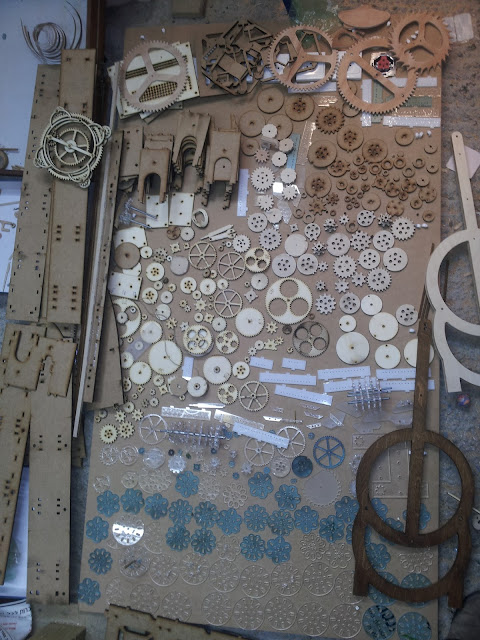פרוייקט פרידברג לחקר הגניזה הנו ארגון העוסק במחקר ובהנגשת קטעי גניזת קהיר. כחלק ממחקרם, המתמקד בדיגיטיזציה של הקטעים ובהנגשתם באמצעות האינטרנט לחוקרים ולציבור הרחב, הם פתחו תוכנה המאפשרת לבדוק התאמה של קרעי גניזה אחד לשני. התוכנה עובדת עם מסך מגע.
מכיוון שממון רב מושקע בפרוייקט, שרוב תוצריו מצויים באינטרנט כתוכנה ולא כמוצר ממשי, הדרישות היו למעמד פיזי מרשים, בעל נוכחות חזקה. שם הפרוייקט צריך להופיע באופן בולט. המעמד מיועד להצגה בכנסים ובהרצאות, ועל כן עליו להיות פריק ונוח להעברה, למרות המסך הגדול והכבד.
המעמד הוא למסך מגע 50 אינצ', ששוקל כ-35 ק"ג. המעמד צריך לאפשר שימוש בעמידה או בישיבה, ועל כן עליו לאפשר כוונון למצבי עבודה שונים בהטיות שונות.
המוצר עשוי מסגרת ורגלים מעץ אגוז בשילוב מייפל, וכן מסגרת ברזל פנימית.
מידות כלליות (במצב שכיבה): גובה - 82 ס"מ, רוחב - 115 ס"מ, עומק 60 ס"מ.
מסגרת העץ עשוייה מעץ אגוז מלא, כשבחזית יצרתי קורת סנדביץ המודבקת 5 שכבות אגוז ומייפל לסירוגין.

המסגרת משתמשת במחברי שיניים ישרות / אצבעות (Box / Finger Joints) שיצרתי בעזרת ג'יג שתכנן המהנדס מתיאס ונדל הקנדי. תיאור מפורט ומורחב מאוד של הג'יג, יכולתיו וצורת בניתו נמצאים כאן, ותיאור ופירוט הג'יג האישי שבניתי נמצא באתרו כאן. נעיר כאן כי הג'יג הזה מאפשר ייצור מחברי שיניים בקשת אפשרויות רחבה מאוד ובמגוון התאמות בלתי מוגבל (לכל עובי משור ובכל קונפיגורציה). הראתי דוגמאות של המחבר שיצרתי בעזרת הג'יג למספר לא מבוטל של נגרים מקצועיים בירושלים, מהשורה הראשונה בתחום, איתם אני עובד באופן יומיומי כחלק מעבודתי בחברה קבלנית בתחום הבנייה בירושלים (התמחות בשוק היוקרה), והתגובות היו נדהמות מבחינת הדיוק וחוזק המחבר (גם ללא דבק כלל), ובהתחשב בשיטת הביצוע (על משור שולחני-קרייזיק המוצב בבית פרטי) ובמשך הביצוע (דקות ספורות).
שילוב המייפל נועד לתת קונטרסט גבוה לגוף האותיות, שנחרטו בכרסום קוני בכרסומת CNC על רקעו הכהה של האגוז, והוא גם מסייע ליצירת מראה ייחודי במחברי השיניים במבט הצד של המעמד. אני מאוד מרוצה מהתוצאה התלת ממדית, ומהאפקט שנוצר מהפונט הסריפי.
הרגליים המרובעות, בחתך 5.5X5.5 ס"מ, עשויות קורות עץ אגוז בעובי 1.5 ס"מ המחוברות בזיווי (45 מעלות) עם מילואת עץ אורן. במחשבה שניה לאחר מעשה- הייתי יוצר את הרגליים ללא מילואת האורן, אלא בקורות מלאות מודבקות בזיווי.
הקושרות עשויות עץ מלא ומחוברות לרגליים במחברי סין ונקב/גרז (Mortise and Tenon), ומחוזקות עם ברגים. הברגים מוסתרים בפקקים מדוייקים שחרטתי מעץ אגוז על מחרטת מתכת.
במחשבה שנייה לאחר מעשה: אני מתכנן לבנות את הג'יג של מתיאס ליצירת מחברי סין וגרז, מופיע כאן. במידה והמחבר מדוייק דיו - אין צורך בחיזוקים כלל. בכל מקרה, הייתי יכול לעשות את החיזוקים מדיבלים מעץ אגוז (במקום להסתפק בברגים בלבד).
המסך יושב בתוך מסגרת מתכת פנימית, המתכווננת בצורה פשוטה וקלה בעזרת מגבה, ומאפשרת עבודה בכל זווית בטווח שבין 100 ל-135 מעלות. השקעתי לא מעט זמן בתכנון המנגנון, כיצד ליצור אותו שישא את המשקל, איך לבנות את המעצור שיאפשר שימוש בטוח, וכו' וכו'. בהברקה של רגע הבנתי כי הג'ק של האוטו נותן את כל אלו בפשטות וביעילות. ובו באמת השתמשתי. תזכורת לעצמי: לקנות דחוף ג'ק חדש לאוטו.
כל עבודת הנגרות, כולל הקצעת העצים, פריסת הקורות, חריטת הדיבלים, שיופים, הדבקות וליטוש, נעשו בסדנה הביתית שלי (11 מ"ר), מלבד מסגרת המתכת שבוצעה ע"י מסגר, חריטת האותיות שכורסמו על מכונת CNC, והלכה הסופית שיושמה בחדר צבע בנגרייה.
תמונות מתהליך העבודה:
אבטיפוס ראשוני מעץ אורן:
הדבקת הקורה המרכזית - פרוניר אגוז, קורת מייפל, קורת אגוז (ליבה), קורת מייפל, פורניר אגוז:
הג'יג ליצירת מחברי האצבע:
הקורה לאחר כרסום האותיות - מוכנה ליצירת המחבר:
יצירת המחברים:
כך נראה המחבר מוכן:
הכנת העצים להדבקת הרגליים, מנוסרים ב45 מעלות:
יצירת מחבר סין ונקב בין הרגליים לקושרות:
הדבקת המסגרת:
הדבקת הרגליים והקושרות:
שני החלקים מוכנים לליטוש:
חורי הברגים מכוסים בפקקים:














.jpg)
.jpg)
.jpg)
.jpg)
.jpg)
.jpg)
.jpg)
.jpg)
.jpg)
.jpg)
.jpg)
.jpg)

.jpg)
.jpg)





















